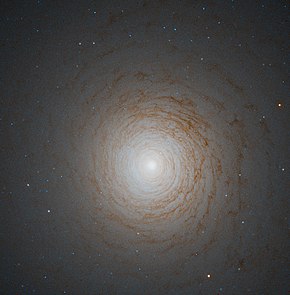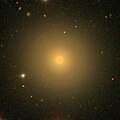| NGC 524 | |
|---|---|
 NGC 524 by
Hubble Space Telescope | |
| Observation data ( J2000 epoch) | |
| Constellation | Pisces |
| Right ascension | 01h 24m 47.7s [1] |
| Declination | +09° 32′ 20″ [1] |
| Redshift | 2403 ± 5 km/ s [1] |
| Distance | 86.1 ± 13.7 Mly (26.4 ± 4.2 Mpc) [1] |
| Apparent magnitude (V) | 10.5 |
| Characteristics | |
| Type | SA(rs)0+ [1] |
| Apparent size (V) | 2.8′ × 2.8′ [1] |
| Other designations | |
| UGC 968, PGC 5222 [1] | |
NGC 524 is a lenticular galaxy in the constellation Pisces. It is at a distance of about 90 million light-years away from Earth. In the central bulge of the galaxy is visible gas forming a spiral structure. [2] It is the largest galaxy in the small NGC 524 group of galaxies, which is associated with NGC 488 and its group. [3] It was discovered by William Herschel in 1786.
Two supernovae have been observed in the galaxy, SN 2000cx, a type Ia-p peaking at 14.5 magnitude, and SN 2008Q, type Ia. [4]
Gallery
-
NGC 524 (SDSS DR14)
-
NGC 524 ( HST)
References
- ^ a b c d e f g "NASA/IPAC Extragalactic Database". Results for NGC 524. Retrieved 2006-11-18.
- ^ "Hubble Eyes a Mysterious Old Spiral". NASA. Archived from the original on 2023-06-09.
- ^ Dmitry Makarov and Igor Karachentsev (2011). "Galaxy groups and clouds in the local (z~ 0.01) Universe". MNRAS. 412 (4): 2498–2520. arXiv: 1011.6277. Bibcode: 2011MNRAS.412.2498M. doi: 10.1111/j.1365-2966.2010.18071.x. S2CID 119194025.
- ^ List of Supernovae IAU Central Bureau for Astronomical Telegrams. Retrieved 29 December 2015.
External links
-
 Media related to
NGC 524 at Wikimedia Commons
Media related to
NGC 524 at Wikimedia Commons - NGC 524 on WikiSky: DSS2, SDSS, GALEX, IRAS, Hydrogen α, X-Ray, Astrophoto, Sky Map, Articles and images
- SEDS
| NGC 524 | |
|---|---|
 NGC 524 by
Hubble Space Telescope | |
| Observation data ( J2000 epoch) | |
| Constellation | Pisces |
| Right ascension | 01h 24m 47.7s [1] |
| Declination | +09° 32′ 20″ [1] |
| Redshift | 2403 ± 5 km/ s [1] |
| Distance | 86.1 ± 13.7 Mly (26.4 ± 4.2 Mpc) [1] |
| Apparent magnitude (V) | 10.5 |
| Characteristics | |
| Type | SA(rs)0+ [1] |
| Apparent size (V) | 2.8′ × 2.8′ [1] |
| Other designations | |
| UGC 968, PGC 5222 [1] | |
NGC 524 is a lenticular galaxy in the constellation Pisces. It is at a distance of about 90 million light-years away from Earth. In the central bulge of the galaxy is visible gas forming a spiral structure. [2] It is the largest galaxy in the small NGC 524 group of galaxies, which is associated with NGC 488 and its group. [3] It was discovered by William Herschel in 1786.
Two supernovae have been observed in the galaxy, SN 2000cx, a type Ia-p peaking at 14.5 magnitude, and SN 2008Q, type Ia. [4]
Gallery
-
NGC 524 (SDSS DR14)
-
NGC 524 ( HST)
References
- ^ a b c d e f g "NASA/IPAC Extragalactic Database". Results for NGC 524. Retrieved 2006-11-18.
- ^ "Hubble Eyes a Mysterious Old Spiral". NASA. Archived from the original on 2023-06-09.
- ^ Dmitry Makarov and Igor Karachentsev (2011). "Galaxy groups and clouds in the local (z~ 0.01) Universe". MNRAS. 412 (4): 2498–2520. arXiv: 1011.6277. Bibcode: 2011MNRAS.412.2498M. doi: 10.1111/j.1365-2966.2010.18071.x. S2CID 119194025.
- ^ List of Supernovae IAU Central Bureau for Astronomical Telegrams. Retrieved 29 December 2015.
External links
-
 Media related to
NGC 524 at Wikimedia Commons
Media related to
NGC 524 at Wikimedia Commons - NGC 524 on WikiSky: DSS2, SDSS, GALEX, IRAS, Hydrogen α, X-Ray, Astrophoto, Sky Map, Articles and images
- SEDS

